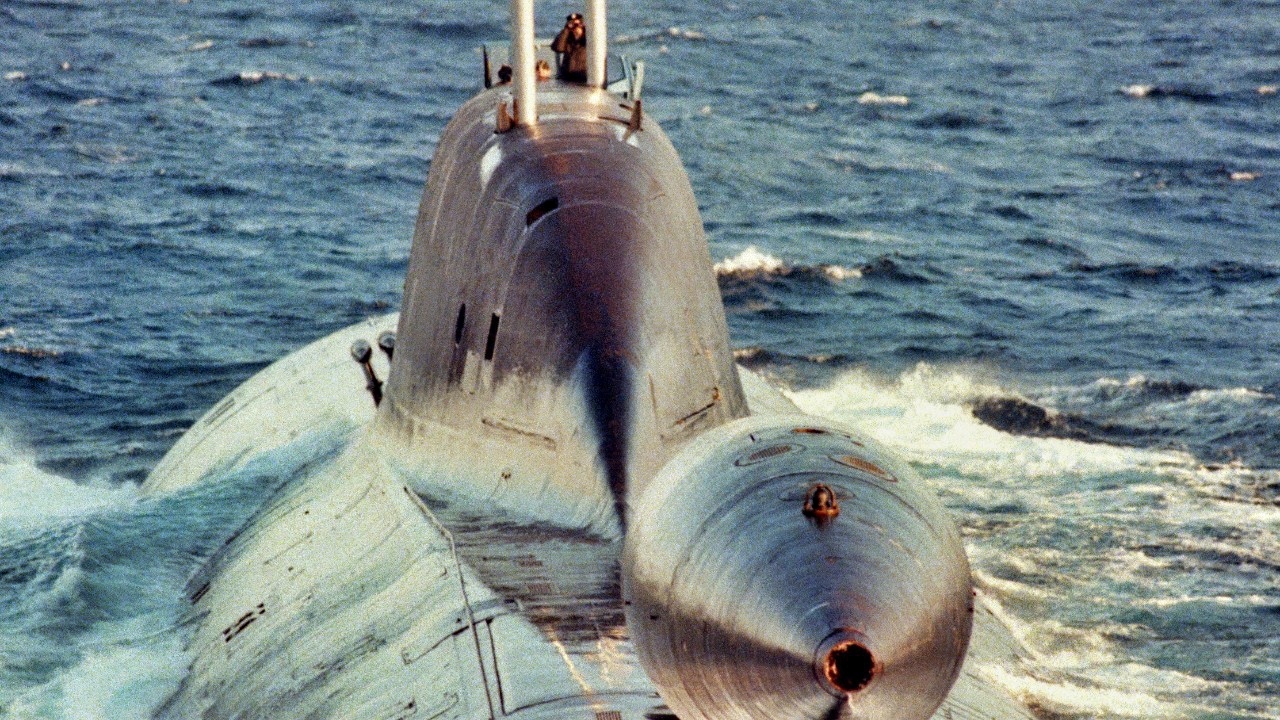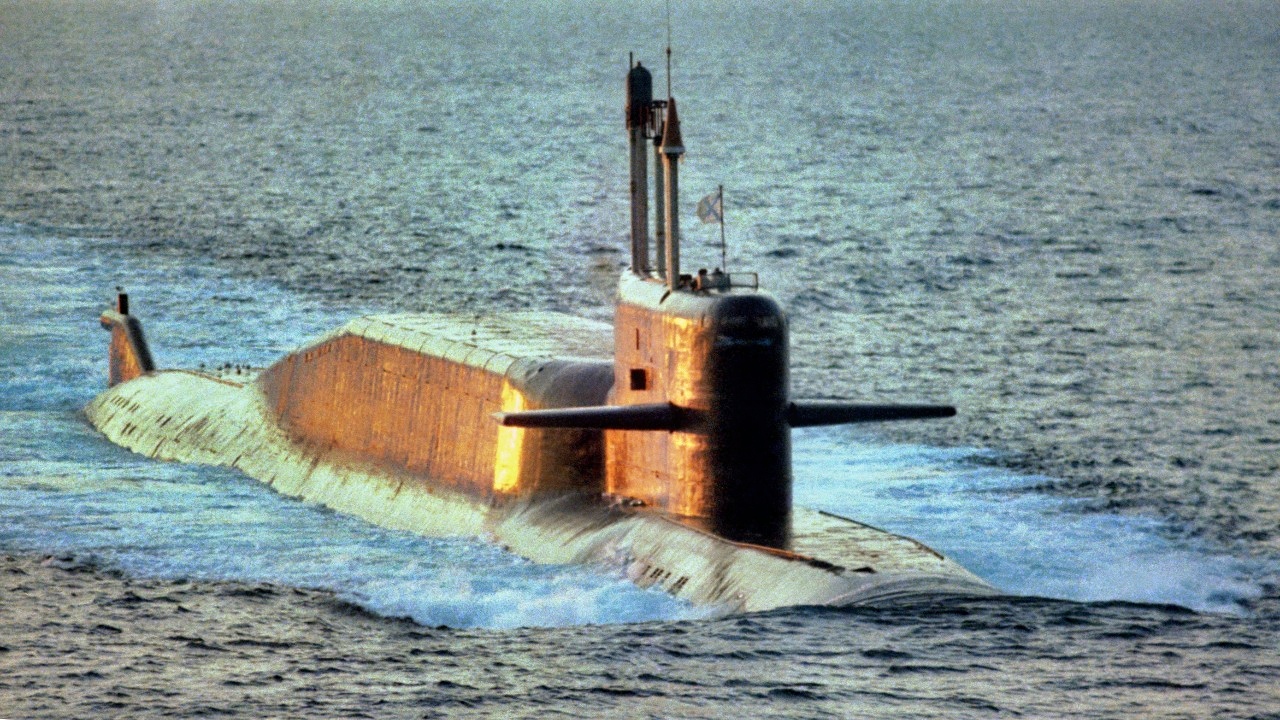Key Points and Summary – A deep dive is taken into the tragic, but often forgotten, 1989 sinking of the K-278 Komsomolets, a unique, deep-diving Soviet nuclear submarine with a titanium hull.
-The submarines, also known in many defense circles as the Mike-class, have two nuclear-armed torpedoes aboard.

Akula-Class. Image Credit: Creative Commons.
-While on patrol in the Barents Sea, a catastrophic fire broke out, disabling the sub and forcing an emergency surface.
-After the fire damaged the hull, the vessel began to flood and ultimately sank.
-Although most of the crew initially escaped, 42 of the 69 sailors perished, primarily from hypothermia in the freezing Arctic waters during a long wait for rescue.
The Soviet Navy’s K-278 Komsomolets Submarine Disaster
When casual history buffs think of military submarine disasters, chances are they recall the August 2000 tragedy that befell the Russian submarine K-141 Kursk — an incident that claimed the lives of 118 matrosiy (sailors).
Meanwhile, students of the Cold War will recall the U.S. Navy’s tragic losses of the USS Scorpion (SS-589) and USS Thresher (SS-593) in May 1968 and April 1963, respectively, which resulted in the combined loss of 228 American submariners.
Finally, they may consider the near-disaster of the Soviet submarine K-19, thanks to the eponymous 2002 motion picture starring Harrison Ford and Liam Neeson.
Considering these more famous incidents, it’s easy to forget another submarine disaster that hit the Soviet Union on April 7, 1989, roughly 2.5 years before the USSR’s collapse.National Security Journal now takes a deeper dive into the sinking of the nuclear-powered attack submarine K-278 Komsomolets.
The Basics/Bottom Line Up Front (BLUF)
An excellent source of information on the K-278 disaster is defense technology analyst Ruta Deshpande’s July article for Deftechtimes.
As Deshpande notes, “The Komsomolets was on a routine patrol in the Arctic when tragedy struck. At 11:00 AM, a fire broke out in the seventh compartment—the rearmost part of the submarine. It was likely caused by a short circuit that ignited leaking hydraulic fluid. Within minutes, the fire spread uncontrollably.
“Key systems failed one by one. The main power bus shut down, the nuclear reactor automatically scrammed, and smoke filled the interior. The heat became extreme, likely reaching over 800°C [1,472°F], melting parts of the submarine’s internal structure.

An aerial stern-on view of the Russian Northern Fleet AKULA class nuclear-powered attack submarine underway on the surface. Image Credit: Creative Commons.

Akula-Class Submarine from Russian Navy. Image Credit: Creative Commons.
“The captain ordered an emergency surfacing at 11:15 AM, and the submarine reached the surface. However, the fire kept burning. Compressed air lines feeding into the fire turned the rear compartment into a furnace. The toxic smoke infiltrated other compartments, and even the emergency breathing systems failed due to contamination.”
Approximately three hours after the onboard conflagration started, the fire began to die down, but in a tragically ironic twist of fate, one danger was displaced by another: Seawater started leaking into the damaged compartments.
The pressure differential between the outside and inside of the vessel worsened the flooding. With serious hull damage and no power to run the pumps, the submarine began to list and lose buoyancy.
By 4:42 p.m., the skipper, Captain 1st Rank Evgeny Vanin, gave the order to abandon ship, and the submarine’s final log entry was made just minutes later. At 5:08 p.m., K-278 sank stern-first at an 80-degree angle into the depths of the Barents Sea.
Most of the crew initially survived the sinking. They were stranded in freezing waters for over an hour before a rescue ship finally arrived. The wait resulted in that aforementioned death toll of 42, with hypothermia being the primary cause of death.
To make matters worse, “The escape capsule also failed. It likely detached only on impact with the seabed. When it resurfaced, the hatch blew open due to pressure change—killing one, drowning three, and leaving only one survivor.”

Submarine Delta IV-Class. Image Credit: Creative Commons.
K-278 Komsomolets (K-278) Initial History and Concept
The Komsomolets was among the few Soviet submarines to receive an actual name, as opposed to a mere alphanumeric designation.
The moniker “Komsomolets” means “member of the Komsomol,” which was the youth organization of the Communist Party, formed in 1918 and was composed of youth 14-28 years old.
K-278 was the lone ship of the Soviet Navy’s Project-685 Plavnik class or Mike-class in some circles.
Project 685 was devised by the Rubin Design Bureau and built by Sevmash in response to an exhortation to develop an advanced submarine that could carry a mix of torpedoes and cruise missiles with conventional or nuclear warheads.
She was laid down on April 22 1978, launched on May 9, 1983, and commissioned on December 28, 1983.
Where Is the Wreck Now?
She lies at a depth of 1,680 meters.
In July 2019, a joint Russo-Norwegian expedition using the Ægir 6000 remotely operated vehicle revealed that the stern section of the submarine remained intact, but the bow showed major damage, including a 20-square-meter hole above the torpedo compartment.
The reactor was found to be leaking radioactive materials such as Cesium-137 and Strontium-90, sometimes at levels hundreds of thousands of times above background levels.
Luckily, the depth of the wreck has helped to quickly dilute the radioactivity level, and scientists found no serious contamination in marine life or fishing areas.
K-278 Technical Specifications and Vital Stats
-Displacement: Surfaced: 5,680–5,750 tons; Submerged: 6,400–8,500 tons
-Hull Length: 117.5–118.4 m (385.4-388.4 ft))
-Beam Width: 10.7–11.1 m (35.1-36.4 ft)
-Draft: 7.4–9.0 m (24.2-29.5 ft)
-Propulsion: 1 x 190 MW OK-650B-3 pressurized water nuclear reactor; 1 x GTZA steam turbine (approx. 43,000 shp)
-Max Speed: Surfaced: 14 knots; Submerged: 30–31 knots
-Endurance: 90 days
-Depth Capabilities: Operational: 1,000 m (3,280 ft); Maximum (Test): 1,020 m (3,350 ft); Hull Crush: ~1,250-1,370 m (4,101-4.494 ft)
-Crew Complement: 57–69 commissioned officers and enlisted seamen (design: 57-64; at time of tragedy: 69)
-Armament: 6 x 533mm torpedo tubes; 22 torpedoes/missiles total. Mix of SAET-60/USET-80 torpedoes, VA-111 Shkval supercavitating torpedoes, 3K10 Granat cruise missiles, URPK-6 Vodopad-PL ASW missiles. Two torpedoes carried nuclear warheads.
The ship had a double hull, with the inner hull having a strong yet lightweight titanium composition that enabled it to dive deeper than any other military submarine. American submarines at the time could only reach 800 meters.
About the Author: Christian D. Orr, Defense Expert
Christian D. Orr is a Senior Defense Editor. He is a former Air Force Security Forces officer, Federal law enforcement officer, and private military contractor (with assignments worked in Iraq, the United Arab Emirates, Kosovo, Japan, Germany, and the Pentagon). Chris holds a B.A. in International Relations from the University of Southern California (USC) and an M.A. in Intelligence Studies (concentration in Terrorism Studies) from American Military University (AMU). He is also the author of the newly published book “Five Decades of a Fabulous Firearm: Celebrating the 50th Anniversary of the Beretta 92 Pistol Series.”
More Military
Merkava: The Best Tank on Earth (Not Made in USA)
The U.S. Air Force’s Big B-21 Raider Stealth Bomber Mistake Still Stings
The U.S. Navy’s Big Ford-Class Aircraft Carrier Mistake Still Stings
Russia’s Admiral Kuznetsov Aircraft Carrier Can’t Stop Pumping Out Toxic Black Smoke
India’s Big Blunder Purchase of Russia’s ‘Mothball’ Aircraft Carrier Still Stings










